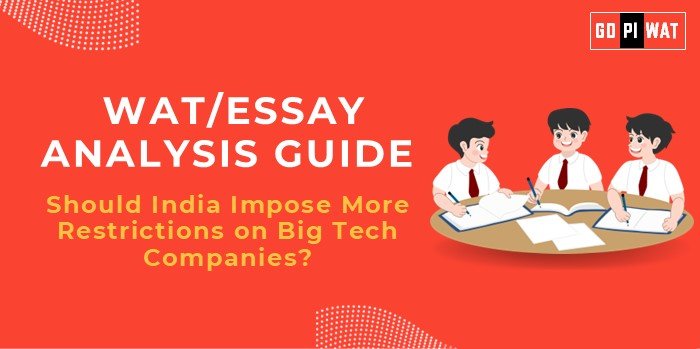📋 Essay Analysis Guide
📝 Topic: Should India Impose More Restrictions on Big Tech Companies?
🌐 Understanding the Topic
🌏 Significance: The regulation of Big Tech intersects technology, governance, and economy, making it vital for understanding policy-making and market dynamics in the B-school context.
📝 Effective Planning and Writing
- ⏳ Time Allocation:
- 🕒 Planning: 5 minutes
- 🖊️ Writing: 20 minutes
- 🔍 Review: 5 minutes
- 📋 Structure:
- 📜 Introduction: 60-70 words
- 📄 Body: 350-375 words
- 📚 Conclusion: 60-70 words
💡 Introduction Techniques for Essays
- ⚖️ Contrast Approach: “India’s booming internet economy contrasts sharply with the regulatory void in addressing Big Tech’s monopolistic tendencies.”
- 🔑 Solution-Based Approach: “Well-structured restrictions can enable fair competition while sustaining Big Tech-driven innovation.”
- 📜 Timeline Approach: “From enabling growth to attracting penalties, Big Tech’s journey in India calls for balanced regulations.”
🛠️ Structuring the Essay Body
- 🏆 Achievements:
- 📈 Economic Growth: Big Tech has contributed significantly to India’s digital economy.
- 💡 Innovation: Companies have fostered technological advancements, including AI and digital platforms.
- 📱 Financial Inclusion: Enabled by digital payment systems like UPI.
- ⚠️ Challenges:
- ⚖️ Monopolistic Practices: Big Tech’s dominance in markets stifles smaller players.
- 🔒 Data Privacy Concerns: Lax regulations have raised concerns about user data exploitation.
- 🌍 Global Comparisons: EU’s strict GDPR policies provide a framework for addressing these challenges.
- 🌟 Future Outlook:
- 📜 Balanced Policies: Integrate transparency, accountability, and innovation-friendly frameworks.
- 📊 Regulatory Enhancements: Strengthen the Competition Commission of India (CCI) to oversee Big Tech practices.
- 🤝 Foster Startups: Create incentives for local SMEs to thrive alongside global giants.
📄 Concluding Effectively
- ⚖️ Balanced Perspective: “Regulating Big Tech in India requires a delicate balance between fostering innovation and ensuring ethical practices.”
- 🌍 Global Comparison: “India can emulate the EU’s measured approach to Big Tech, adapting it to local dynamics for maximum efficacy.”
📊 Analyzing Successes and Shortcomings
🎯 Successes
- 📈 Digital Economy Growth: Contributed significantly to GDP and employment.
- 💡 Innovation: Advancements in AI, fintech, and e-commerce.
- 📱 Digital Payments: UPI adoption revolutionized financial transactions.
⚠️ Challenges
- ⚖️ Market Monopolization: Big Tech’s dominance threatens local players.
- 🔒 Data Privacy: Lack of comprehensive data protection laws raises user concerns.
- 🌐 Content Moderation: Inadequate policies to address misinformation and hate speech.
🔑 Recommendations for Sustainable Progress
- 📜 Implement Robust Data Protection Laws: Enact comprehensive legislation similar to GDPR.
- 📊 Enhance Regulatory Capabilities: Strengthen CCI to monitor Big Tech activities effectively.
- 💼 Incentivize Startups and SMEs: Support innovation and reduce dependency on foreign tech giants.
- 🌐 Transparency Measures: Mandate clearer user policies and data practices from Big Tech firms.
📚 Sample Short Essays
- 📋 Balanced Perspective: “India’s digital economy thrives on Big Tech, yet unchecked dominance necessitates ethical and equitable regulations.”
- 🔍 Solution-Oriented: “Penalizing malpractice through global turnover-based fines demonstrates India’s intent to ensure fair market practices.”
- 🌍 Global Comparison: “India’s approach to regulating Big Tech can draw from EU frameworks, tailoring solutions for local challenges.”


